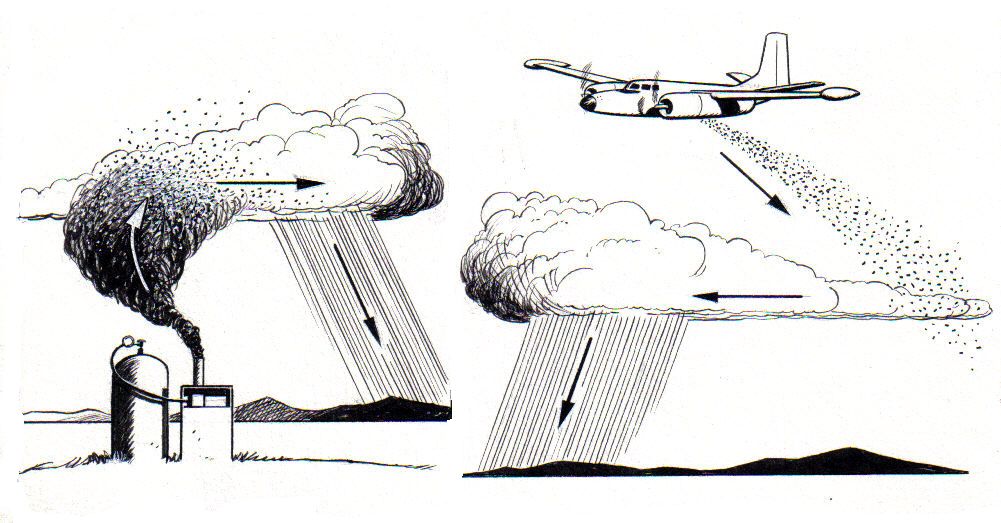
The recent storm in Dubai that resulted in wide spread flooding. Airport runways were covered in inches of water and led to speculation that this was the result of cloud seeding. Though UAE has a long tradition of cloud seeding, this time, other factors were to blame for the flooding. What is this technique? That which sounds like something straight out of a sci-fi novel, is actually a scientific method used to enhance precipitation. The process involves planes or drones dispersing substances into the clouds, encouraging them to clump together and fall as rain. And it’s not just for show; cloud seeding can help alleviate water scarcity in arid regions, boost agricultural production, and even reduce the temperature. So, grab your umbrella (something you wouldn’t expect to need in Dubai!) and let’s dive into the fascinating world of cloud seeding, where every drop of rain is a drop of hope for a greener future.
What is Cloud Seeding?
Let’s start at the beginning. Cloud seeding is like nature’s helping hand in the sky, a technique used to enhance precipitation in clouds. It’s a bit like giving Mother Nature a gentle nudge when she needs it most. Here’s how it works:
- Introducing Cloud Seeding Agents: Scientists deploy substances called cloud seeding agents into clouds, such as silver iodide, potassium iodide, or even plain old salt particles.
- Triggering Raindrop Formation: These particles act as nuclei, around which water droplets can form. When the conditions are just right, these droplets grow larger and eventually fall as rain or snow.
But hold on, isn’t this just playing with nature? Well, fear not, dear reader, for this process is conducted with careful consideration for environmental impact and safety.
The Science Behind the Magic
Now, let’s dive a little deeper into the science behind this rain-enhancing phenomenon. It’s all about understanding the intricate dance of moisture, temperature, and atmospheric dynamics:
- Cloud Composition: Clouds are made up of tiny water droplets or ice crystals suspended in the air. Cloud seeding agents provide surfaces for these particles to coalesce and grow.
- Temperature Matters: Cloud seeding is typically done in clouds that are already primed for precipitation but might need a little extra encouragement. By seeding the clouds, we capitalize on existing atmospheric conditions to maximize the chances of rain or snowfall.
- Natural Processes: It’s essential to recognize that cloud seeding isn’t about creating rain out of thin air (pun intended). Instead, it’s about nudging nature along, amplifying natural processes to increase precipitation in regions that need it most.
How is this achieved?
 Cloud seeding is conducted through various methods, including aircraft dispersal and ground-based generators. Aircraft release seeding agents into clouds, targeting areas where precipitation is desired. Ground-based generators use rockets or cannons to disperse seeding agents into the atmosphere, often in mountainous regions where clouds form.
Cloud seeding is conducted through various methods, including aircraft dispersal and ground-based generators. Aircraft release seeding agents into clouds, targeting areas where precipitation is desired. Ground-based generators use rockets or cannons to disperse seeding agents into the atmosphere, often in mountainous regions where clouds form.
These methods strategically deploy seeding agents to optimize rainfall in specific areas, contributing to water resource management and agricultural sustainability. By understanding the techniques behind cloud seeding, we can appreciate its role in harnessing the power of nature to benefit communities worldwide.
Applications and Benefits
You might be wondering, “Where does cloud seeding come into play in the real world?” Well, let me enlighten you on some of its practical applications and the benefits it brings:
- Drought Mitigation: In regions experiencing drought or water scarcity, cloud seeding can help bolster water resources by increasing rainfall.
- Agricultural Support: Farmers rejoice! Cloud seeding can aid in ensuring consistent water supplies for crops, promoting agricultural productivity.
- Wildfire Prevention: By inducing rain in dry areas, cloud seeding can also play a role in mitigating the risk of wildfires, protecting both lives and ecosystems.
Debunking Myths and Addressing Concerns
Now, before we wrap up our rainy adventure, let’s address a few common misconceptions and concerns surrounding cloud seeding:
- “It’s Unnatural!” While it’s true that cloud seeding involves human intervention, it’s essential to recognize that we’re merely working with the natural processes already at play in the atmosphere.
- Environmental Impact: Extensive research has been conducted to assess the environmental impact of cloud seeding, with studies showing minimal adverse effects on ecosystems.
- Ethical Considerations: Cloud seeding programs are typically conducted with oversight from regulatory bodies and adherence to ethical guidelines to ensure responsible and sustainable practices.
Conclusion: Embracing the Rainmaker Within
As we bid adieu to our journey through the clouds, I hope you’ve gained a newfound appreciation for the marvels of weather modification and the role of cloud seeding in shaping our atmospheric landscape. So, the next time you feel a raindrop kiss your skin, remember the intricate dance of science and nature that brought it to you.
Until next time, keep looking up, stay curious, and may your skies be ever abundant with rain!








No Comment! Be the first one.